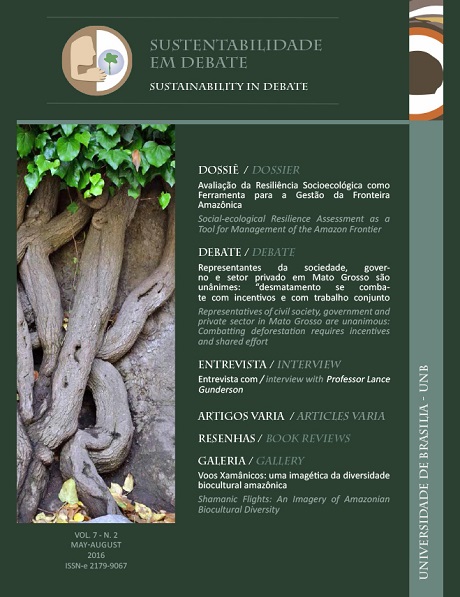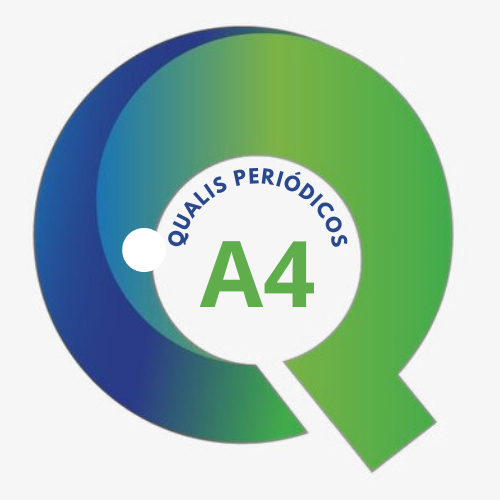Socioecological dynamics and resilience of ornamental fishing in Barcelos, Rio Negro, Amazonas, Brazil
DOI:
https://doi.org/10.18472/SustDeb.v7n2.2016.15127Keywords:
Pesca Ornamental, Resiliência, Sistemas Socioecológicos, Ciclo AdaptativoAbstract
We characterize the dynamics of ornamental fishing in the municipality of Barcelos (Brazilian Amazon) from the perspective of socio-ecological systems and resilience theory. Using the adaptive cycle as a heuristic model, we present the social actors involved in the activity, its history and some factors related to its collapse is suggested. Although ornamental fishing might be ecologically and socially viable, economic factors contributed greatly to its decline. The traditional use of multiple natural resources, cash transfer programs and income opportunities from the commercial and sport fishing, are factors that are contributing to the reorganization of the system. The effects of these changes are not known yet, but an increase in fishing pressure on stocks can adversely affect the resilience of the ecological system.
Downloads
References
ARAUJO, M. L. G.; CHARVET-ALMEIDA P.; ALMEIDA M. P.; PEREIRA H. Freshwater stingrays (Potamotrygonidae): status, conservation and management challenges. Information document AC, 20 Inf. 8. p. 1-6. 2004.
ARMITAGE, Derek and JOHNSON, Derek. Can Resilience Be Reconciled with Globalization and the Increasingly Complex Conditions of Resource Degradation in Asian Coastal Regions? Geography and Environmental Studies Faculty Publications. Paper 5. 2006.
BATISTA, V. S.; ISAAC, V. J.; VIANA, J. P. Exploração e manejo dos recursos pesqueiros da Amazônia. In: Ruffino, M. L. (Ed.). A pesca e os recursos pesqueiros da Amazônia brasileira. Ibama/Provárzea, Manaus, AM. p. 63-151. 2004.
BÉNÉ, C. MACFAYDEN, G. ALLISON, E.H. Increasing the contribution of small-scale fisheries to poverty alleviation and food security. FAO Fisheries Technical Paper. 481. 125 p. 2007.
BERNARD, H. R. Research methods in anthropology. 2nd Ed.Lanham, Md.; New York; Toronto: Altamira Press. 696 pp. 2011.
BUSCHBACHER, Robert. A Teoria da Resiliência e os Sistemas Socioecológicos: Como se preparar para um Futuro Imprevisível? Boletim Regional, Urbano e Ambiental, v.9, p. 11-24, 2014.
CARPENTER, S., WALKER B., ANDERIES J. M., and N. ABEL. From metaphor to measurement: resilience of what to what? Ecosystems v. 4. Pp. 765-781. 2001.
CHAO, N. L.; PRANG, G.; PETRY P. The Fishery, Diversity, and Conservation of Ornamental Fishes in the Rio Negro Basin, Brazil ”“ A review of Project Piaba (1989-99). In: N. L. Chao et al. (Eds.). Conservation and Management of Ornamental Fish Resources of the Rio Negro Basin Amazonia, Brazil ”“ Project Piaba. Editora Universidade do Amazonas, Manaus, AM. p. 161-204. 2001.
CINNER, J., M. M. P. B. FUENTES, and H. RANDRIAMAHAZO. Exploring social resilience in Madagascar’s marine protected areas. Ecology and Society. v.14, n.1, p. 41. 2009.
COOMES, O.T. & TAKASAKI, Y. Targeting conservation-development initiatives in tropical forests: insights from analyses of rain forest use and economic reliance among Amazonian peasants. Ecological Economics v. 51, n., p.47”“64. 2004.
COOMES, O.T; TAKASAKI Y., ABIZAID F.C., BARHAM B.L. Floodplain fisheries as natural insurance for the rural poor in tropical forest environments: evidence from Amazonia. Fisheries Management and Ecology. V. 17, n. 6, p. 513”“521. 2010.
COOMES O.T; BARHAM, B.L. Rain Forest Extraction and Conservation in Amazonia Oliver T. Coomes and Bradford L. Barham. The Geographical Journal. v. 163, n. 2, p. 180-188. 1997.
COTE, M., NIGHTINGALE, A. J. Resilience thinking meets social theory”¯: Situating social change in socio-ecological systems (SES) research. Progress in Human Geography, v.36, n.4, p. 475”“489. 2012.
COULTHARD, S. Can we be both resilient and well, and what choices do people have? Incorporating agency into the resilience debate from a fisheries perspective. Ecology and Society, v. 17, n.1. 2012.
GILLINGHAM S. Social Organization and Participatory Resource Management in Brazilian Ribeirinho Communities: A Case Study of the Mamirauá Sustainable Development Reserve, Amazonas. Society & Natural Resources: An International Journal. v.14, n. 9, p. 803-814. 2001.
GOULDING, M.; CARVALHO, J. L.; FERREIRA, E.G. Rio Negro: Rich Life in Poor Water. Hague: SBP Academic Publishing. 200 pp. 1988.
GUNDERSON L.H, HOLLING CS, LIGHT S.S. Barriers and bridges to the renewal of ecosystems and institutions. New York: Columbia University Press. 1995.
GUNDERSON, L. H., and HOLLING, C. S. (editors). Panarchy: understanding transformations in human and natural systems. Island Press, Washington, D.C., USA. 2002.
HOLLING, C. S. Resilience and stability of ecological systems. Annual review of ecology and systematics, p. 1-23, 1973.
HOLLING, C. S. The resilience of terrestrial ecosystems: local surprise and global change. Pages 292-317 in W. C. CLARK and R. E. MUNN, editors. Sustainable development of the biosphere. Cambridge University Press, Cambridge, UK. 1986.
HOLLING, C. S. Understanding the complexity of economic, ecological, and social systems. Ecosystems v. 4, p.390-405. 2001.
INSTITUTO BRASILEIRO DE MEIO AMBIENTE E DOS RECURSOS NATURAIS. IBAMA. <http://www.ibama.gov.br/areas-tematicas-recursos-pesqueiros/peixes-ornamentais>. 2014. Acesso em: 28 agosto 2014.
INSTITUTO BRASILEIRO DE GEOGRAFIA E ESTATÍSTICA ”“ IBGE. Disponível em: <http://www.ibge.gov.br/home/.2014>. Acesso em: 28 agosto 2014.
MOREAU M.;. COOMES O. T. Aquarium fish exploitation in western Amazonia: conservation issues in Peru. Environmental Conservation. v.34, p. 1222. 2007.
OLIVIER, K. The ornamental fish market. Globefish Research Programme. United Nations Food and Agriculture Organization, FAO, Rome, 67: 1-92. 2001.
OSTROM E. A General Framework for Analyzing Sustainability of Social-Ecological Systems. Science. v. 325, p. 419. 2009.
OSTROM, E. Beyond Markets and States”¯: Polycentric Governance of Complex Economic Systems. American Economic Association. v. 100, n.3, p. 641”“672. 2010.
PRANG, G. A caboclo society in the Middle Rio Negro basin: ecology, economy and history of an ornamental fishery in the state of Amazonas, Brazil. Tese Doutorado. Wayne State University. 300 pp. 2001.
PRANG, G. An industry analysis of the freshwater ornamental fishery with particular reference to the supply of Brazilian freshwater ornamentals to the market. Uakari. V 3, n.1, p.7-51. 2007.
REIS, A. C. F. (1999). Manaós e outras Villas. 2a Ed. Rev. EDUA. Governo do Estado do Amazonas.
SALATI E., Marques, J. The Climatology of the Amazon region. In: Sioli, H. (Ed.). The Amazon Limnology and landscape ecology of mighty tropical river and its basin. Dr W. Junk Publishers, Dordrecht. p. 85-126. 1984.
SANTOS, G. M.; FERREIRA, E., J. G. Peixes da Bacia Amazônica. In: LOWE-MCCONNEL, R. H (Ed.). Estudos Ecológicos de Comunidades de Peixes Tropicais. Editora Universidade de São Paulo. p. 345-373. 1999.
SEIXAS, C., E BERKES F.; Dynamics of social-ecological changes in a lagoon fishery in southern Brazil. In: F. BERKES, J. COLDING, and C. FOLKE, editors. Navigating Social-Ecological Systems. Cambridge University Press, Cambridge, UK. pp 271-290. 2003.
SILVA, A. L. Uso de recursos por populações ribeirinhas do Médio Rio Negro. Tese (Doutorado) Universidade de São Paulo. São Paulo-SP. 237 p. 2003.
SOARES F. V., RIBAS R. P., OSÓRIO R. G. Evaluating the Impact of Brazil's Bolsa FamIlia: Cash Transfer Programs in Comparative Perspective. Latin American Research Review, V. 45, N. 2, pp. 173-190. 2010.
SOBREIRO. Territórios e conflitos nas pescarias do médio Rio Negro (Barcelos, Amazonas, Brasil). Dissertação (mestrado). Manaus: INPA/UFAM 154 pp. 2007.
SOBREIRO. Urban-Rural Livelihoods, Fishing Conflicts and Indigenous Movements in the Middle Rio Negro Region of the Brazilian Amazon. Bulletin of Latin American Research, v.34, n.1, p. 53”“69. 2015WALKER, B., HOLLING, C. S., CARPENTER, S. R., and KINZIG, A. Resilience, adaptability and transformability in social--ecological systems. Ecology and society, v. 9, n. 2, p. 5, 2004.
WALKER, B. H., L. H. GUNDERSON, A. P. KINZIG, C. FOLKE, S. R. CARPENTER, and L. SCHULTZ. A handful of heuristics and some propositions for understanding resilience in social-ecological systems. Ecology and Society v.11 n.1, p.13. 2006.
WEINSTEIN, B. The Amazon Rubber Boom, 1850”“1920. Stanford University Press, Stanford, California. 1983.
Downloads
Published
How to Cite
Issue
Section
License
SUSTAINABILITY IN DEBATE – Copyright Statement
The submission of original scientific work(s) by the authors, as the copyright holders of the text(s) sent to the journal, under the terms of Law 9.610/98, implies in the concession of copyrights of printed and/or digital publication to the Sustainability in Debate Journal of the article(s) approved for publication purposes, in a single issue of the journal. Furthermore, approved scientific work(s) will be released without any charge, or any kind of copyright reimbursement, through the journal’s website, for reading, printing and/or downloading of the text file, from the date of acceptance for publication purposes. Therefore, the authors, when submitting the article (s) to the journal, and gratuitous assignment of copyrights related to the submitted scientific work, are fully aware that they will not be remunerated for the publication of the article(s) in the journal.
The Sustainability in Debate Journal is licensed under Creative Commons License – Non-Commercial-No-Derivation Attribution (Derivative Work Ban) 3.0 Brazil, aiming at dissemination of scientific knowledge, as indicated on the journal's website, which allows the text to be shared, and be recognized in regards to its authorship and original publication in this journal.
Authors are allowed to sign additional contracts separately, for non-exclusive distribution of the works published in the Sustainability in Debate Journal (for example, in a book chapter), provided that it is expressed the texts were originally published in this journal. Authors are allowed and encouraged to publish and distribute their text online, following publication in Sustainability in Debate (e.g. in institutional repositories or their personal pages). The authors expressly agree to the terms of this Copyright Statement, which will be applied following the submission and publishing by this journal.






